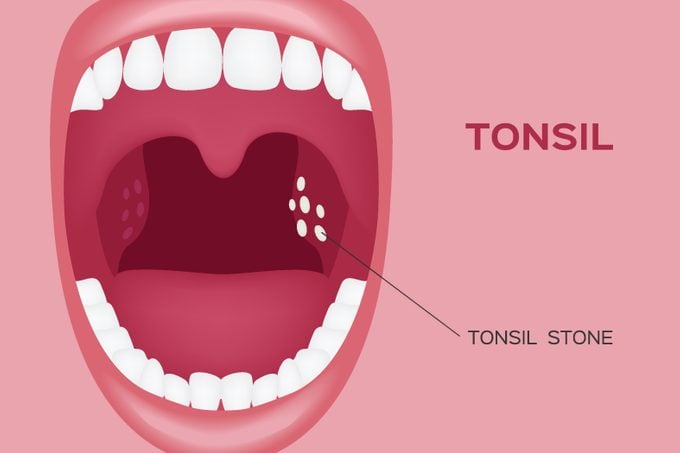6 Silent Signs of Tonsil Stones
Updated: Jun. 30, 2022
Just one more reason your dentist was right about flossing; learn the six signs of tonsil stones and what to do about them.
Tonsils have a surprising purpose—they help defend the body from infections. But they can also be a huge source of pain. If you’ve ever experienced tonsil stone pain, for instance, you know they can be annoying at best and may even require surgery at worst. According to a study published in 2014 in ISRN Dentistry, tonsil stones affect about 8 percent of adults.
What are tonsil stones?
Tonsil stones are calcifications in the tonsils. They may form too deep in the tonsils for you to see them with a mirror, but they’re usually light yellow or white. They’re similar to the plaque that forms on teeth, according to a study in the Journal of Otolaryngology-Head and Neck Surgery.
How do tonsil stones form?
Our tonsils work as part of our overall immune system by trapping bacteria and filtering out germs. The stones occur when bits of food, bacteria, or dead skin cells get caught in the tiny crevices in your tonsils. As particles get pushed together in the tonsils, they form hard balls known as tonsil stones.

What are the signs of tonsil stones?
Many people who have tonsil stones have no symptoms. Luckily, if they’re not bothering you, there is likely nothing you need to do about them.
If you do have symptoms, though, you may experience redness and irritation in your tonsils, infections such as tonsillitis, a sore throat (make sure you know the signs of strep throat), or pain when swallowing. Tonsil stones cause also cause bad breath. That’s because of the bacteria that grow on them. Some people with tonsil stones may also report feeling pain or pressure in their ears.
Who is most susceptible?
Experts don’t know exactly why some people develop frequent tonsil stones while others don’t, but there are a few factors to consider. According to Kyra Osborne, MD, a head and neck specialist at the Cleveland Clinic, people with more or deeper crevices in their tonsils are more susceptible to developing tonsil stones. Tonsil stones may also be more common in teenagers.
How are tonsil stones treated?
If you notice small tonsil stones that are not painful or causing other symptoms, you may be able to remove them yourself. Simply press the back of your toothbrush against them. To avoid swallowing or choking on them, be sure to push them forward. Sometimes vigorous gargling can do the trick as well.
If you can’t remove them yourself, your doctor may be able to. Experiencing frequent tonsil stones may be a sign you need to have your tonsils removed. If that’s the case, be wary of this odd side effect a tonsillectomy could have on your fertility.
Some people are simply more susceptible to tonsil stones. But practicing excellent oral hygiene can help prevent them. Be sure to brush your teeth twice daily and floss at least once per day. Rinsing with an alcohol-free mouthwash every day could help as well.



